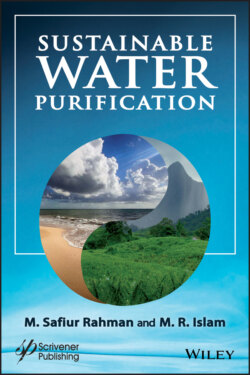Читать книгу Sustainable Water Purification - M. R. Islam - Страница 14
1.3 Background
ОглавлениеWater is a transparent, tasteless, odorless, and nearly colorless chemical substance, which is the main constituent of Earth’s hydrosphere, and the fluids of most living organisms. It is vital for all known forms of life, even though it provides no calorie organic nutrients. Its chemical formula is H2O, meaning that each of its molecules contains one oxygen and two hydrogen atoms, connected by covalent bonds. Water is the name of the liquid state of H2O at standard ambient temperature and pressure. It forms precipitation in the form of rain and aerosols in the form of fog. Clouds are formed from suspended droplets of water and ice, its solid state. When finely divided, crystalline ice may precipitate in the form of snow. The gaseous state of water is steam or water vapor. Water moves continually through the water cycle of evaporation, transpiration (evapotranspiration), condensation, precipitation, and runoff, usually reaching the sea. The distribution of water on the Earth’s surface is extremely uneven. Only 3% of water on the surface is fresh; the remaining 97% resides in the ocean. Of freshwater, 69% resides in glaciers, 30% underground, and less than 1% is located in lakes, rivers, and swamps. Looked at another way, only one percent of the water on the Earth’s surface is usable by humans, and 99% of the usable quantity is situated underground.
Due to different types of natural and anthropogenic activities surface and ground water become contaminated. Water pollution by toxic pollutions (inorganic and organic) has become a subject of interest especially since the establishment of the EPA (Environmental Protection Agency) in 1970. The problem of water quality degradation of both surface and sub-surface streams has been evident for a long time. Achieving an acceptable quality of surface water focuses on reducing emissions of known pollutants to within safe industrial and drinking standards. In developing nations, many of today’s industrial projects are environmentally hostile.
The quality of drinking water is an important factor in determining human welfare. It has been noted that polluted drinking water is the cause for waterborne diseases which wiped out the entire populations of cities. The major sources of water pollution are domestic waste from urban and rural areas, and industrial wastes which are discharged into natural water bodies. The rivers and lakes near urban centres emit disgusting odours and fish are being killed in millions along the sea coasts.
Extensive studies of the subject of water pollution by toxic pollutions (inorganic and organic) have been developed during the recent years. In today’s world, the study and research of pollutants should not be confined to their more removal or relocation. Economic feasibility, one of the key factors in any engineering project, must be addressed. Many of today’s engineering works are environmental friendly but that criterion is no longer sufficient. Time has come to make environmental works appealing rather than friendly. Islam and Wellington (2001) gave much stress on the development of environmentally appealing research projects mentioning introduction of novel methods in the areas of engineering research.
